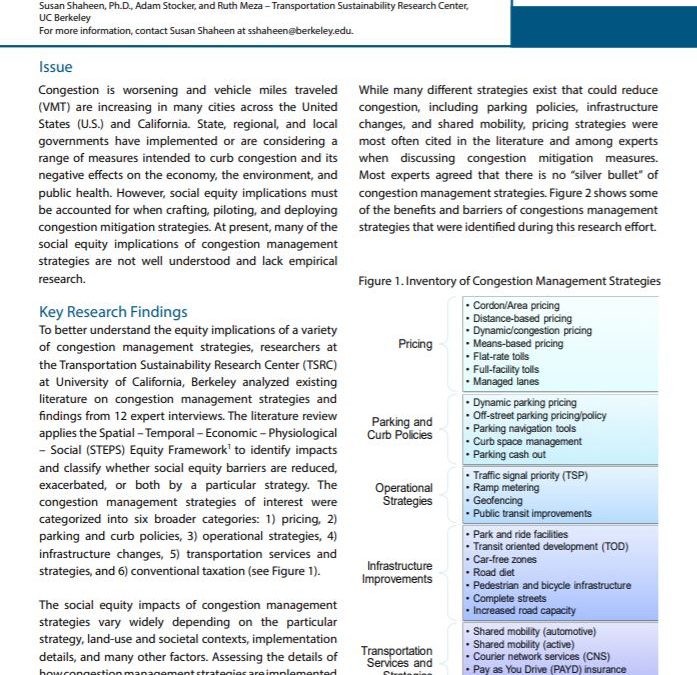by Innovative Mobility Research | Sep 22, 2021 |
Mobility on Demand (MOD) Sandbox Demonstrations Independent Evaluation (IE) – Regional Transportation Authority (RTA) of Pima County Adaptive Mobility with Reliability and Efficiency (AMORE) Project Evaluation Plan Date: August 2018 Author(s): Cordahi, Gustave; Shaheen, Susan; Martin, Elliot Abstract: The Mobility on Demand (MOD) Sandbox Demonstration Program provides a venue through which integrated MOD concepts and solutions – supported through local partnerships – are demonstrated in real-world settings. For each of the 11 MOD Sandbox Demonstration projects, the MOD Sandbox Independent Evaluation includes an analysis of project impacts from performance measures provided by the project partners, as well as an assessment of the business models used. This report constitutes the Evaluation Plan for the Regional Transportation Authority (RTA) of Pima County Adaptive Mobility with Reliability and Efficiency (AMORE) Sandbox project. It includes the following chapters: project overview; evaluation approach and process; evaluation schedule and management; and data collection & analysis plan. View...
by Innovative Mobility Research | Oct 7, 2020 |
Authors: Susan Shaheen, PhD, Adam Cohen, Jacquelyn Broader, Richard Davis, Les Brown, Radha Neelakantan, Deepak Gopalakrishna Date: March 1, 2020 Abstract: This report provides Mobility on Demand (MOD) planning and implementation practices and tools to support communities. The report discusses different stakeholders in the MOD ecosystem and the role of partnerships in filling spatial, temporal, and other service gaps. Additionally, the report discusses how MOD can be integrated into transportation planning and modeling. The report also discusses shared mobility implementation considerations, such as rights-of-way management, multimodal integration, data sharing, equity, labor impacts, and the role of pilot evaluations. Finally, the report discusses technology developments with implications for the MOD ecosystem, such as shared automated vehicles (SAVs), urban air mobility (UAM), and last-mile delivery innovations. This report is a practical resource with: 1) current practices for planning and implementing MOD; 2) case studies and lessons learned; 3) considerations to help public agencies advance MOD in their communities; and 4) resources and recommended reading. View PDF. ...
by Innovative Mobility Research | Apr 14, 2020 |
Authors: Stephen Wong, Joan Walker, and Susan Shaheen Date: April 2020 Abstract: This paper examines the opportunities for addressing evacuations by leveraging the sharing economy. To support this research, we use a mixed-method approach employing archival research of sharing economy actions, 24 high-ranking expert interviews, and a survey of individuals impacted by Hurricane Irma in 2017 (n=645). Using these data, we contribute to the literature in four key ways. First, we summarize sharing economy company actions in 30 U.S. disasters. Second, we discuss results from 24 expert interviews on 11 sharing economy benefits (ranging from resource redundancy to positive company press coverage) and 13 limitations (ranging from driver reliability to the digital divide). Experts included six directors/executives of emergency/transportation agencies, two executives of sharing economy companies, and eight senior-level agency leaders. Third, we use these interviews, specifically negative opinions of the sharing economy, to inform our Hurricane Irma survey, which contributes empirical evidence of the feasibility of shared resources. Despite just 1.1% and 5.4% of respondents using transportation network companies (TNCs, also known as ridesourcing and ridehailing) and homesharing respectively during the Irma evacuation, some respondents were extremely willing to offer their own resources including transportation before evacuating (29.1%), transportation while evacuating (23.6%), and shelter for free (19.2%) in a future disaster. We also find spare capacity of private assets exists for future evacuations with just 11.1% and 16% of respondents without spare seatbelts and beds/mattresses, respectively. Finally, we conclude with practice-ready policy recommendations for public agencies to leverage shared resources including: communication partnerships, surge flagging (i.e., identifying and reducing unfair price increases), and community-based sharing systems. View...
by Innovative Mobility Research | Mar 26, 2020 |
Authors: Jeffrey Lidicker, Timothy Lipman, PhD, and Susan Shaheen, PhD Date: January 2010 Abstract: This study examines the relative economics of electric vehicle operation in the context of current electricity rates in specific utility service territories. The authors examined 14 utility territories offering electric vehicle (EV) rates, focusing on California but also including other regions of theUnited States. The consumer costs of EV charging were examined in comparison with gasoline price data, geographic location, and during three highly variable gasoline price periods of July 2008, January 2009, and July 2009. In a switch from a conventional 23 mile per gallon (10.2liters/100 kilometers) vehicle to a 300 watt-hours/mile electric vehicle driven 10,000 miles (16,100 km) per year, the study finds that savings in fuel costs ranged from approximately $100US to $1,800US annually, with considerable geographic variation and with higher-endvalues mostly in Summer 2008 when gasoline prices were relatively high. Charging off-peak instead of during peak periods saves an average of only a few hundred dollars US per year,rendering the incentive to charge off-peak a relatively small one except perhaps during some summer months when the on-peak prices are especially high. Gasoline price variances have a larger effect and switching from a low fuel economy conventional vehicle to the reference EV(compared with a switch from an already efficient vehicle) presents the highest savings level. The West and Midwest are generally the most favorable regions for EV economics, when EV charging rates and gasoline prices are considered together. View...

by Innovative Mobility Research | Jan 2, 2020 |
Authors: Susan Shaheen, PhD, Adam Stocker, and Ruth Meza Date: December 2019 Abstract: To better understand the equity implications of a variety of congestion management strategies, researchers at the Transportation Sustainability Research Center (TSRC) at University of California, Berkeley analyzed existing literature on congestion management strategies and findings from 12 expert interviews. The literature review applies the Spatial – Temporal – Economic – Physiological – Social (STEPS) Equity Framework to identify impacts and classify whether social equity barriers are reduced, exacerbated, or both by a particular strategy. The congestion management strategies of interest were categorized into six broader categories: 1) pricing, 2) parking and curb policies, 3) operational strategies, 4) infrastructure changes, 5) transportation services and strategies, and 6) conventional taxation. View...

